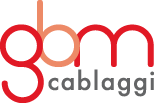In order to monitor the organizational system of the company and offer its clients products certified according to the key safety and quality standards, Gbm has pledged to obtain the most important internationally recognized certification for its production.
Quality
-
ISO 9001 CERTIFICATION
Gbm created an internal organizational system whose requirements fully comply with the requirements of ISO 9001.
To download Gbm’s ISO 9001 certificate, click here.
To download Gbm’s quality policy, click here.
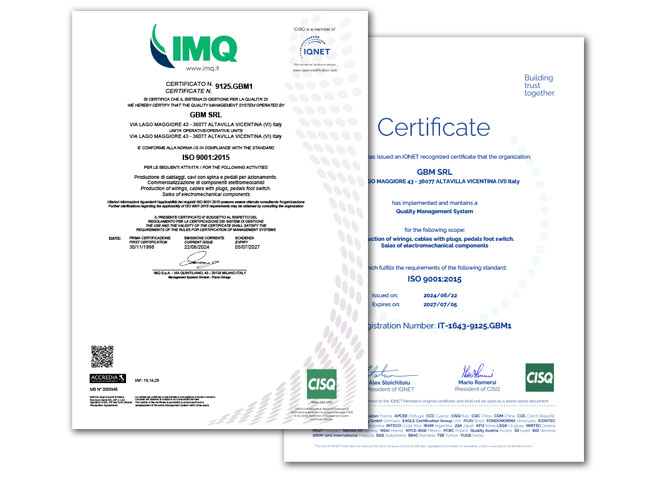
-
UL CERTIFICATION
To provide greater security to customers who export to the U.S. and the Canadian market, Gbm has recently obtained UL certification. This recognition guarantees the use of UL certified raw materials, therefore facilitating homologation of the end product.
To download GMB’s UL Certificate, click here.
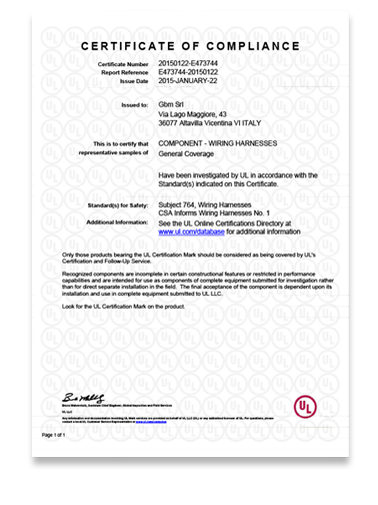
Environment
Gbm has been certified according to ISO 14001 (UNI EN ISO 14001) for a long time now. The company decided to implement and maintain an environmental management system that allows it to operate according to the rules and requirements contained in that standard, so as to not only monitor the environmental impacts of its activities, but also to systematically seek improvement.
To download Gbm’s ISO 14001 certificate, click here.
To download Gbm’s environmental policy, click here.
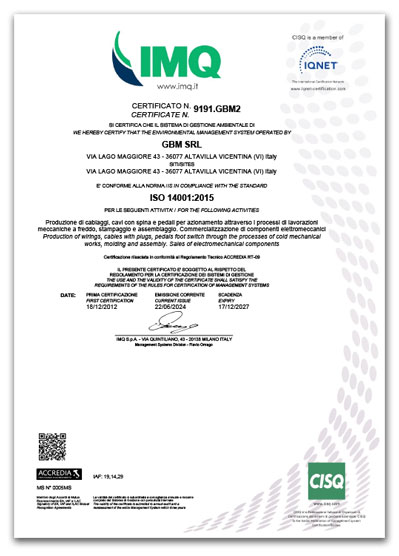
Safety
In order to improve the working environment and constantly monitor its development, Gbm strives to implement and continuously improve a system of management of health and safety at work.
To download ISO 45001 di Gbm certificate, click here
To see Gbm’s Safety and Health Policy document, click here.
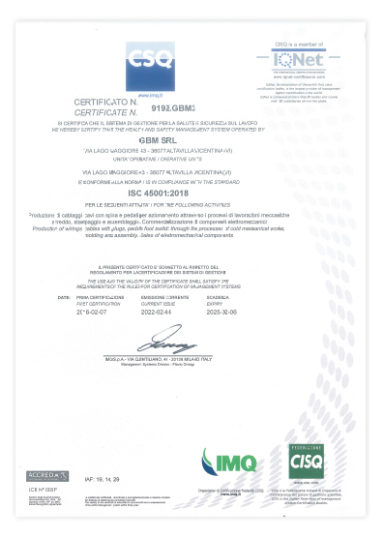
Sustainability
Gbm, to manage its ability to meet the needs of the present without compromising the ability of future generations to meet their own, has set the benchmarks in the corporate Sustainability Policy.
To measure and improve its sustainability, it’s registered in the EcoVadis Ratings portal, which examines the following business areas:
- Environment
- Labor and Human Rights
- Ethics
- Sustainable Sourcing
and releases an assessment of the company’s performance.
For the year 2025 Gbm was awarded with a “Bronze Medal” and was placed in the top 35% of all companies evaluated by Ecovadis.
To download the Gbm Sustainability Policy, click here.
To download the EcoVadis assessment of Gbm, click here.
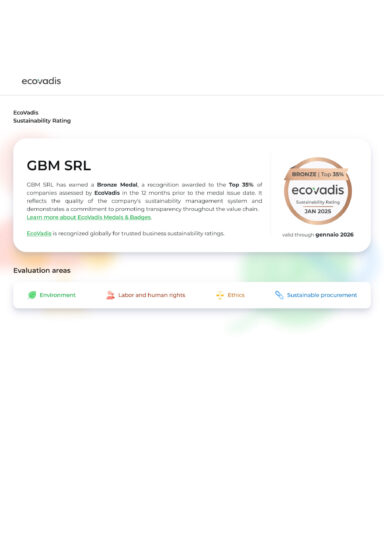
ENVIRONMENT
All of our products comply with the most important European Directives (REACH and RoHS) while our suppliers guarantee a relentless monitoring of the SVHC list in order to verify, if any, the presence of substances that, though allowed, must be reported.
Restriction of Hazardous Substances, RoHS o Direttiva 2002/95/CE
In 2003, the European Union (EU) issued the Restriction of Hazardous Substances Directive, also known as RoHS Directive or 2002/95/EC Directive).
The EU has prepared this new directive in order to protect the environment and the health of those people who usually work with electrical and electronic equipment (EEE).
This regulation is predominantly targeted at eliminating the concentration of given substances from the electrical and electronic appliances that fall under the scope of application of the same directive. As a consequence, all EU Member states must guarantee that, effective on 1 July 2006, the new electrical and electronic appliances put in the market do not contain any of the prohibited substances.
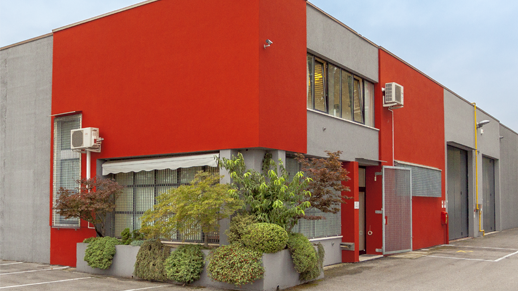
Restriction of Hazardous Substances, RoHS o Direttiva 2002/95/CE
In 2003, the European Union (EU) issued the Restriction of Hazardous Substances Directive, also known as RoHS Directive or 2002/95/EC Directive).
The EU has prepared this new directive in order to protect the environment and the health of those people who usually work with electrical and electronic equipment (EEE).
This regulation is predominantly targeted at eliminating the concentration of given substances from the electrical and electronic appliances that fall under the scope of application of the same directive. As a consequence, all EU Member states must guarantee that, effective on 1 July 2006, the new electrical and electronic appliances put in the market do not contain any of the six prohibited substances reported below:
-
Lead (Pb) and its compounds
-
Mercury (Hg)
-
Cadmium VI (Cd-VI) and its compounds
-
Hexavalent chrome and its compounds
-
Polybrominated biphenyl (PBB)
-
Polybrominateddiphenyl ethers (PBDE)
-
Pentha, otta, deca- BDE (Bromdiphenylether)

REACH ed SVHC LIST
REACH is the acronym of Registration, Evaluation, Authorisation and Restriction of Chemicals. The REACH Regulation has come into force on 1 June 2007 and serves the purpose of rationalising and improving the previous regulatory framework on chemical substances in the European Union (EU), and it does so through the “SVHC list”, being one of its key instruments.
REACH has also instituted the European Chemicals Agency (ECHA), playing a key role in coordinating and implementing the entire process. The ECHA is based in Helsinki (Finland) and has the mandate to manage the registration, evaluation, authorisation and restriction processes involving chemicals, for the purpose of guaranteeing EU-wide consistency.
The continuous and rapid evolution of the REACH (European Regulation concerning the registration, evaluation, authorisation and restriction of chemicals) provides for the periodical update of the Candidate List where the extremely concerning (SVHC substances) substances are listed.
It is important, then, when referring to a Safety Data Sheet (MSDS) of a product, to know that this list is available, in order to have the opportunity to verify whether such “extremely concerning” substances are indeed present in the product.
Code of ethics
Gbm gives utmost importance to the ethical respect throughout the carrying out of its business activity, therefore an Organizational Model (Ex D. Lgs. 231/2001) has been drafted, with the aim of regulating the society, ensuring the maximum transparency and legality.
To download the Gbm Code of Ethics, click here


 Italiano
Italiano